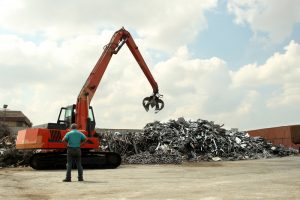The EPA issued an enforcement alert about Clean Air Act (CAA) emissions violations at scrap metal recycling facilities in late July 2021. Emissions from these facilities are contributing to violations of the National Ambient Air Quality Standards (NAAQS) for ozone.
“Over 250 metal recycling facilities are currently operating with a shredder in the United States,” according to the EPA. “These facilities are often located in densely populated areas – noncompliant shredders can have an impact on overburdened communities. This Alert is intended to inform metal recycling facility owners and operators about the [CAA] requirements that might apply at their facilities and the air pollution control systems that are in use for shredders at similar facilities. Specifically, shredder operators should be aware of the amount of volatile organic compounds (VOCs) and other emissions from their facilities and should contact their local regulatory or permitting authority for further guidance. Enforcement actions have assessed substantial penalties and have required the installation of emission control equipment.”
The EPA test data reveals that typical shredding operations emit VOCs at rates between 20 and 200 pounds of VOCs per hour. Test results vary by the efficiency of the capture equipment, leading the EPA to conclude that “emissions rates from shredders are likely higher than these rates.”
“Rates of uncontrolled VOC emissions correlate to the size of the shredder and the type of material shredded,” according to the enforcement alert. “Emission rates are generally reduced if the shredder has an enclosure and existing controls such as a cyclone or scrubber. Emission rates are also generally reduced where the facility removes contaminants before shredding (known as ‘depolluting’).
“Permit thresholds for VOC emissions vary depending on whether the shredder is in an area that meets the NAAQS for ozone or is in an ozone transport region,” the alert continues.
The EPA reminds industry of the following regulations: “Major sources are subject to permitting requirements and facilities with VOC emissions above certain thresholds are required to undergo a New Source Review (NSR) or Prevention of Significant Deterioration (PSD) review for new and modified sources. Depending on the location, existing facilities may be subject to Reasonably Available Control Technology (RACT) regulations at different emission thresholds. In addition, some states require facilities to obtain a permit or install controls at VOC emission thresholds lower than those for NSR, PSD, or RACT. Failure to comply with any of these requirements is a violation of the [CAA], which could lead to enforcement actions. In such actions, facilities may be required to install add-on controls, pay civil penalties, and take other measures.”
Enforcement examples
Schnitzer Steel (California)
The company’s Oakland, California, location reached a settlement with the California Attorney General on February 3, 2021, that required it to pay penalties of $4.1 million, “implement supplemental environmental projects and make significant changes to its operations and practices.” Schnitzer is also required to install temporary continuous emissions monitors (CEMs), an acid control system, and two regenerative thermal oxidizers by December 2022.
Sims Metal Management New England Corp. (SMM)
The EPA and the State of Rhode Island found that SMM was operating a 7,000-horsepower (hp) shredder in Johnston, Rhode Island, creating a major VOC emissions source without a permit or installing required emissions controls. The SMM settlement agreement, reached in September 2020, required the company to pay $2 million in state penalties and $250,000 in federal penalties. The company is also required to “install a control train consisting of an enclosure, fans, pollution controls to reduce particulate matter, a regenerative thermal oxidizer to reduce VOCs, and an acid gas scrubber.”
Prolerized New England Company (dba Schnitzer Northeast)
At its Everett, Massachusetts, location, the State of Massachusetts found the company’s 9,000-hp shredder was a major source of VOC emissions. The company’s settlement with the state included a penalty of $900,000 and the installation of “a control train consisting of an enclosure, fans, drop out boxes to reduce large particles, venturi scrubbers to reduce small particles, regenerative thermal oxidizers to reduce VOCs, and acid gas scrubbers.”
Best practices
To reduce VOC emissions, the EPA recommends the industry best practice of depollution, which includes removal and recovery or proper disposal of certain fluids and certain materials before shredding. This course of action will help prevent fires and explosions during shredding operations. These fluids and materials include:
- Gasoline and diesel fuel
- Oil
- Antifreeze
- Brake fluid
- Transmission fluid
- Lead-acid batteries
- Vehicle air bags
- Capacitors and transformers
- Switches and light ballasts containing mercury
- Tires
- Compressed gas cylinders
- Refrigerants in appliances such as air conditioners, dehumidifiers, and refrigerators
The EPA also recommends companies that own and operate scrap metal shredders estimate hourly and annual VOC emissions using appropriate available test data from similar facilities.
- If estimated total annual or hourly VOC emissions are below but near the RACT or NSR/PSD thresholds for your area, consult with the EPA or the state environmental agency, and consider conducting a performance test to measure actual VOC emissions and develop a facility-specific emissions factor.
- If estimated emissions are over the RACT or NSR/PSD thresholds, contact the EPA or the state environmental agency to discuss a path forward. In some cases, the installation of capture and add-on pollution controls may be required.

